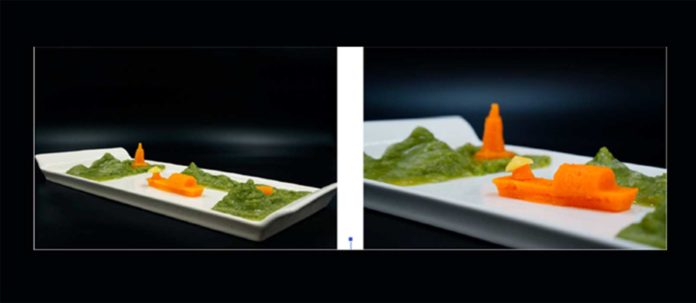3D food printing means creating food quickly in a desired shape and texture. Food inks are used for this purpose. The food inks are made from the dehydrated food and freeze-dried powders, and it contains a high percentage of food additives such as hydrocolloids (HCs) to stabilize the ink and enable a smoother printing process.
But due to the high amount of hydrocolloids, the taste, texture, and aroma of the food change, making it unappetizing to patients with dysphagia. This may lead to reduced food consumption and malnutrition among patients.
Scientists from Nanyang Technological University, Singapore (NTU Singapore), Singapore University of Technology and Design (SUTD), and Khoo Teck Puat Hospital (KTPH) have overcome this problem by creating a new way to make “food inks.” They developed a new way to create “food inks” from fresh and frozen vegetables that better preserve their nutrition and flavor than existing methods.
Doing this, they were able to -preserve the nutrition of the printed food in a better way and make it more palatable.
This new method is expected to increase meal consumption by patients.
Scientists also discovered that the food used to create food inks could be categorized into three categories, with each requiring a different hydrocolloid treatment to become printable. For instance, garden pea, carrot, and bok choy were chosen as representatives in each category, requiring no HCs, one type of HC, and two kinds of HCs, respectively.
Asst Prof Yi Zhang, the principal investigator from the NTU team, said, “Our technology helps to provide dysphagic patients with adequate nutrient-rich and safe diets. Their feeding is more dignified, enabling them to socialize and consume meals that look, feel and taste like regular food. Our method of 3D printing fresh vegetables can be used easily in hospitals, nursing homes, daycare centers for the aging population with dysphagia and other swallowing disorders. Our research is also another step forward in digital gastronomy, where we can cater to specific requirements prescribed by dieticians, such as nutrition customization and visual appeal.”
Prof Chua Chee Kai, corresponding author and the Head of Pillar, Engineering Product Development at SUTD, added: “The next frontier of additive manufacturing is 3D food printing. As the 3D food printing landscape is increasingly evolving, we are excited to continue pushing the boundaries of this industry to find innovative solutions for global issues such as food security and sustainability.”
Gladys Wong, co-principal investigator and Senior Principal Dietitian from KTPH, said: “3D Food Printing is more than a novelty. I believe it will be a viable approach to provide sustenance and nourishment to our increasingly aging population. Our frail, elderly patients, as well as those with swallowing difficulties, will be able to enjoy a visually presentable and pleasurable dining experience even with a restrictive diet of smoothly pureed dishes.”
Journal Reference:
- Aakanksha Panta et al. 3D food printing of fresh vegetables using food hydrocolloids for dysphagic patients. DOI: 10.1016/j.foodhyd.2020.106546
